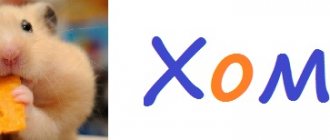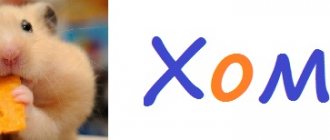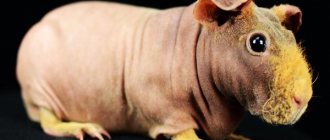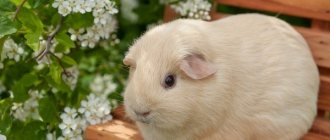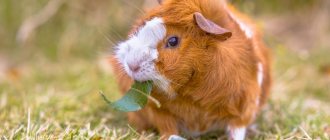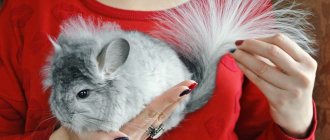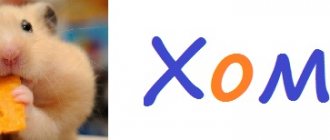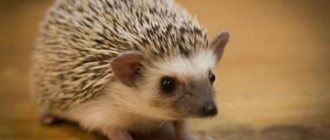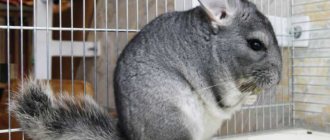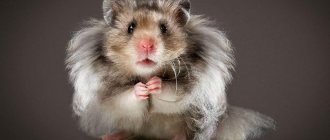Guinea pigs have long been popular pets. These cute rodents are easy to purchase in pet stores or at the Bird Market. However, the animals sold there are often outbred (crossbred) because they do not have any documents confirming their origin. Of course, this will not prevent the pig from becoming a pet, but if you plan to engage in serious breeding of these animals, then such a “breeding breeder” can please you with an unpredictably diverse offspring. For breeding, you should purchase purebred pigs of known origin. Today there are a number of clubs for guinea pig lovers that coordinate the activities of breeders and organize exhibitions. In these clubs you can purchase young animals of different breeds with pedigrees. The choice of breeds is quite large: from the already familiar smooth shorthaired, Peruvian and Abyssinian, to a variety of rare and exotic ones (curly Texels, crested Cresteds, etc.). In general, today there are more than 80 breeds of guinea pigs, differing in the structure, length and color of their coat, and thanks to the work of breeders, more and more new ones are appearing. The most popular marine breeds will be discussed in this article.
There are various classifications of guinea pig breeds in the literature. One of the most common classifications is the division of guinea pigs into three large groups - long-haired, short-haired and rare. Modern breeders also use the following option for dividing into groups:
- English Self - guinea pigs of solid color (solid color)
- Long Hair non Selfs - (Sheltie, Peruvian, Coronet, Texel, Alpaca, Merino)
- Short-haired (woolen) (Coated, non Selfs) - (agouti, American and English Cresteds, Abyssinians, Rexes, etc.).
- Rare Varieties are so-called new breeds that are still quite rare.
The range of colors in guinea pigs is also very diverse; they can be completely monochromatic (white, black, buff, red, chocolate), agoute (natural color), variegated, two or three colors, and even Dalmatians.
Selfies
Selfies are one of the ancient representatives of the pig family. They were developed in Great Britain in the 19th century. A distinctive feature of Selfies is their uniform (solid) coat color (white, black, brown, beige, lilac, etc.). The eyes are often dark, but can also be red. The photo shows a guinea pig of the English Self breed.
One interesting feature of this breed has been noticed: females living together in the same cage or enclosure take care of the offspring through joint efforts; we can say that these are the only family rodents of their kind.
Nutrition
It is important to know what guinea pigs eat so that there are no health problems for your pets. In nature, the rodent feeds on seeds, berries, leaves and roots.
At home, pigs need to eat hay and ready-made balanced feed. For dessert, you can give him nibble on fresh vegetables, salad and fruits.
To allow teeth to be ground down, cherry branches are placed in the cage. It is more convenient to pour water into the sippy cup every day, so it will not spill and will provide the pet with the necessary moisture.
Abyssinian (rosette) guinea pigs
The Abyssinian breed is one of the most popular. Abyssinians first appeared in England in 1861 as a result of a mutation in the coat gene, and in 1866 the first individuals were brought to Europe.
A characteristic feature of the Abyssinian breed is a special growth of hair, which is why rosettes are formed (the hair in the rosettes diverges from the center to the periphery). Rosettes must be of the correct shape and have clear boundaries. The total number of sockets is 8-10, maximum 12. The standard specifies their location: 2 on the nose, 1-2 on the shoulders, 4 on the sides and 4 on the back of the body. In addition, they must be symmetrical. In some individuals, as a result of mutation, the number of rosettes can reach 30 pieces - these are no longer considered purebred. The rosettes located nearby form tufts, or ridges. Any colors are possible. The fur reaches 3-4 cm in length; in females it is softer than in males. The body of Abyssinian pigs is strong, muscular, and moderately long. The shoulders and chest are wide, the back is straight, the back is rounded. The legs are straight and short. The head is short, rounded, with large ears, large shiny eyes and a slightly elongated nose (this is called a Roman nose).
All in rosettes - Abyssinian
It is very easy to distinguish Abyssinians - they are completely in rosettes, the hair is not very long, about 3-4 centimeters. This coat does not require additional care. There should be eight rosettes, evenly distributed throughout the body. Abyssinians have a more active character and are big fans of running. They are friendly towards the owner, but they get into fights with their relatives much more often.
Peruvian guinea pigs
This is a fairly old breed, known in Europe since the mid-19th century. In Peruvian pigs, the hair grows forward, towards the muzzle from two rosettes located on the rump, and falls over the eyes. Ideally there should be only 2 sockets at the bottom. The length of the coat must be at least 15 cm, and for show-class Peruvians it can reach 50 cm.
Alpaca
Alpacas are very similar to Peruvian guinea pigs, but have a more wavy coat that also grows forward towards the face. There are two sockets at the back.
Sheltie
In England, Shelties were recognized in 1973, in the USA - in 1980.
The long coat, which grows strictly from the muzzle downwards, is soft and silky. Unlike alpacas, Abyssinian and Peruvian guinea pigs, there is not a single rosette on the body. There are different colors.
Coronets
The same shelties, but on the crown there is a rosette that looks like a crown.
Training
The guinea pig is trainable. Different individuals may need additional time to learn.
Most popular tricks:
- respond to a name and come to a call;
- stand on hind legs when required;
- run in a circle for a treat;
- roll the ball and climb over the hoops;
- go to the toilet in the tray.
Texels
Texel is one of the most beautiful breeds, known since the mid-80s of the last century. Texels are distinguished by long, thick fur that breaks up into clearly defined curls, a long train and fluffy sideburns. The length of the coat is 12-18 cm. The rounded muzzle is decorated with large expressive eyes. Texels are calm, friendly and sociable.
Looking at the photo of a Texel guinea pig, it seems that caring for such luxurious fur requires special effort. In reality, they do not require daily brushing, and it does not take much time to select hay and sawdust from their fur. Animals that do not take part in exhibitions usually have their fur shortened.
Merino
The curly coat grows in the same way as the Texel, only there is a rosette on the head.
Agouti
Agoutis are the ancestors of all modern breeds. Each animal's hair has different shades at the base and at the end.
Roans
The head, paws, ears are painted in the main color without any admixture of another shade, only on the body there is a so-called salt and pepper mixture, when hairs of one color are mixed with hairs of another color.
Teddy
Teddies are similar to Rex cats, but their fur is slightly shorter and softer. Thick, dense and elastic, straight (or slightly wavy), the hair stands on end all over the pig's body, and feels like plush. Pictured is a Gold and White American Teddy
Rex
The main difference between Rex guinea pigs is their hard, dense, slightly curly fur, about 1.7 cm long. The hairs stand on end, which creates a plush effect. Color options can be any.
Ridgeback
It is a smooth-haired pig, but there is a difference - there is a rosette on the rump, and on the back the hair is collected into a kind of comb of standing vertical hair.
Cresteds
Smooth-haired pigs with a rosette on the crown. There are English and American Cresteds. In American cats, the color of the rosette should contrast with the color of the main color; in English cats, it should be identical to it.
Satin guinea pigs
A distinctive feature of the satin pig group is its surprisingly soft, silky coat with a glossy effect. The wool shines and shimmers due to the special hollow structure of the hairs. The Satin coat type is found in all short-haired and long-haired breeds. The rarest animals are golden, lilac and buffalo in color.
Feeding
Pigs eat plant foods. Their diet contains both dry food and succulent food. There should be more of the latter, but not too much, otherwise it will lead to diarrhea. Juicy foods include grass, greens, and vegetables. Sometimes fruits or berries are offered in small quantities as a treat. A variety of vegetables are offered. A large amount of one product will lead to negative results. For example, too much white cabbage will cause flatulence in your pig. Feeding is carried out at the same time, because The animal’s gastrointestinal tract needs regular portions of new food, which “moves” the previous one through the intestines. The pet may die if it does not receive food within 18 hours.
Pigs, like other rodents, periodically eat their own excrement. This is due to the fact that vitamins K and B remain in the primary, soft feces, which are necessary for maintaining health. Therefore, it is better not to purchase a cage with a special tray. This is convenient in terms of hygiene - long hair gets dirty less, but then the pet will not be able to take doses of natural vitamins and will have to buy them additionally at the pharmacy.
The pig's water is changed every day. Use filtered or boiled at room temperature. Cold water leads to colds or pneumonia. On average, a pet drinks up to 80 ml of water per day. If your pig drinks little, most likely she needs enough fluid from succulent food.
Skinny
These pigs of truly exotic appearance appeared as a result of a mutation in 1978 at the Institute of Montreal (Canada). They have no fur, only on the nose and paws there are sparse curly and coarse hairs. Skinny skin is very soft and velvety. The most common color is chocolate; there are black, tortoiseshell, silver, lilac, etc.
Skinnies have an excellent appetite, which is not surprising: they have a faster metabolism, as they need to retain body heat. Therefore, they eat 3 times more than their furry counterparts, sometimes gnawing on something all day long.
Due to their lack of fur, skinnies require a little more care and attention than regular guinea pigs. The main thing that future owners of these cute and gentle creatures need to know is that skinnies need to be protected from drafts and always kept warm. If fasting days are only beneficial for most animals, then for skinnies to remain for two days without food is literally like death. At the same time, skinnies are prone to obesity, so the owner’s task is to carefully consider the diet, establish a diet and strictly adhere to it.
Baldwins
Unlike Skinnies, who have tufts of hair on their paws and nose, Baldwins are a completely hairless breed. Babies are born covered with fur, like ordinary pigs, but by the age of one month it completely falls out. Baldwins have extremely delicate skin; both cold and direct sunlight are dangerous for it.
A person who has decided to get a guinea pig and has become acquainted with all the variety of breeds faces a difficult question: how to choose “your breed” among all this diversity?
Surely, many people want to have a rare breed of pig at home. Thus, hairless guinea pigs are very in demand and popular today. But here you need to take into account that these are more delicate and sensitive animals, they are more demanding in terms of care and living conditions. And the price for such exotics will be significantly higher than for pigs of less rare breeds. In addition, when purchasing a pig of a rare breed with a good pedigree, additional responsibility is imposed on the owner: you need to join a club, take part in exhibitions, find your pet the most suitable partner for mating, etc.
Pigs of less rare breeds can be no less beautiful and affectionate pets. Short-haired guinea pigs are easier to care for, they have high immunity, which means they get sick much less often than other breeds of pigs. Animals with short hair are the best choice for a novice breeder. In addition, if you are purchasing a guinea pig for a child, it is best to choose just such a pet. Caring for rosette pigs is also not very difficult, but they are somewhat more expensive. As for guinea pigs of long-haired breeds, they need more thorough coat care, which will require much more time.
- Guinea pig and...
- Why sea...
- Toys for…
- Guinea pig care
- How to choose and...
- Where and when is best...
Habits
In most cases, very calm and affectionate animals. Rodents show their character in an unusual way. If they are happy, they may jump around the cage and make squeaking noises.
Small individuals are afraid of people and constantly hide in a safe place. It is necessary to accustom the animal to hands carefully without stress.
Aggression manifests itself only after the birth of offspring. For a month, the female will not let anyone near the babies and will defend herself in all known ways.
If the pig is chewing on the cage, then it is bored or there is not enough space. You can expand the cage, play more often, or add another individual. It is dangerous to chew on a cage.
The norm for these animals is to eat their own droppings. Thus, the animal saturates its body with the remaining beneficial substances.
But it’s better to clean the cage in time and expand the diet with vitamins. Your pig may chatter his teeth, which is a sign of stress. It is necessary to temporarily remove irritants.
Interesting Facts
- The main difference between porpoises and dolphins is that they do not tolerate life in captivity. The maximum period of life in a water enclosure does not exceed three years.
- They are very sensitive to the environment; dirt in sea water is another reason for the death of these peaceful animals.
- Until the mid-twentieth century, they were exterminated en masse.
- It was only in 1964 that fishing for this species was banned at the state level.
- Even today, poachers exterminate mammals; they are not even stopped by sanctions in the form of fines that must be paid to those who conduct illegal fishing.
- In 2007, a remarkable phenomenon happened at the Danish Aquarium: in captivity, a female large porpoise gave birth; for the scientific world this was a real event.
Lifestyle
Typically, porpoises are timid and fearful animals. They live alone or in small groups. It is quite difficult to see, and even more so, to pursue them, so many residents of coastal areas are not even aware of their existence. The only species that approaches moving vessels is the white-winged pig. It is a fast swimmer, and when the animal emerges, fountains of splashes are noticeable. It is much more difficult to notice the common or finless varieties emerging from the surface, although the first species may jump horizontally out of the water in strong excitement or when chasing fish. The Californian porpoise is especially shy; even very few scientists have ever observed it during the mating season of many species, which occurs during a certain season - usually the end of spring - the beginning of summer. Pregnancy lasts 9-10 months, after which one baby is born. At birth, the baby's body length is 65-85 cm and weighs about 5 kilograms. The grown cub sometimes remains close to the mother even after breastfeeding has stopped.
White feathered pig
The mating season of many species occurs during a certain season, usually late spring - early summer. Pregnancy lasts 9-10 months, after which one baby is born. At birth, the baby's body length is 65-85 cm and weighs about 5 kilograms. The grown cub sometimes remains close to the mother even after breastfeeding has stopped.
Description
One of the smallest marine mammals. The individuals that make up the porpoise family are quite similar in appearance and skeletal structure to dolphins. They also have a fish-like body with horizontal caudal fins.
For reference: The oldest fossilized remains of porpoises found in the North Pacific Ocean date back to the late Miocene (about 10-12 million years ago). The first true dolphins appeared around this time, and the common ancestor of the two families, Kentriodontidae, died out shortly thereafter.
Although porpoises are not capable of communicating through speech, they still exchange information using various signals in the form of clicks and whistles. Moreover, the signals used by these animals are only pulsed in nature, while at the same time monotonous whistles are recorded in dolphins. Some types of pulse signals are needed for echolocation, others serve to display the emotions of the individual itself. These are fast and agile swimmers, reaching speeds of up to 55 km/h (15 m/s).
Owner reviews
Experienced pig owners often share tips and tricks for caring for their pets. Many people warn that it costs about 1.5-2 thousand rubles per month to maintain an animal, not counting visits to the veterinarian, if such are required. The pet will need bedding material, dry food and vegetables. The latter are given cut into large pieces so that the animal can grind down its incisors while feeding.
Trimming nails requires care and patience - not all pets like this procedure. In some cases, the help of a second person is needed to firmly hold the struggling animal. Additionally, use coarse material for bedding or let the pig run around more often so that the claws wear down naturally. Overgrown claws prevent the pet from moving and deform the feet.
You need to be prepared that pigs, especially long-haired ones kept indoors, shed all year round. Therefore, you will have to not only clean your pet’s cage, but also regularly clean clothes and furniture.
Hygiene and grooming
Owners of long-haired pigs pay a lot of attention to hair care. Your pet should be brushed daily with a soft brush. This prevents the formation of mats and some skin parasites. During combing, the hairs are saturated with oxygen, which makes the fur look shiny and well-groomed. In addition, the process of combing calms the pet and brings him pleasure.
It is better to cut off the resulting tangles, because... unraveling will cause unnecessary anxiety for both the owner and the animal. Many pigs do not like water treatments. If the pet gets dirty, do not bathe it, but carefully wash the stained area, then dry it with a towel and then with a hairdryer at low power.
If there is no need or desire to leave long hair, it can be trimmed regularly, especially in the summer - this will keep the pet cooler and more comfortable. Or at least trim the bangs above the eyes so that the pig can see better and not spoil his vision. Wearers who like long locks use small elastic bands, clips or curling irons to hold their hair together, avoiding tangles and messes. In addition, this makes it easier for the animals to move around.
In addition to the fur, it is necessary to take care of your pet’s claws and ears. Growing claws are regularly trimmed with scissors or a special nail clipper. The ears are cleaned with cotton swabs, first lightly moistened in vegetable oil - to prevent infections.
Pet health
The animals have strong immunity, so infectious diseases rarely bother them. They usually appear if the pet often walks outside or if one of the household, including other animals, gets sick. Common infectious diseases include:
- skin infections;
- salmonellosis;
- toxoplasmosis;
- ringworm;
- coccidiosis.
In addition, a pet can be harmed by physical injury or a violation of the diet: spoiled or poisonous foods, intolerance (allergy) to some component. In this case, cystitis, conjunctivitis, and neoplasms are possible. Foods prohibited for pigs include:
- dairy products;
- products of animal origin;
- sweets;
- flour;
- cooked food from the common table.
The first sign that your pet is feeling unwell is a decrease in appetite or refusal to eat. In such cases, you should find out the reason for this behavior as soon as possible and take action. Prolonged hunger strikes lead to exhaustion of the body and worsening of the disease.
